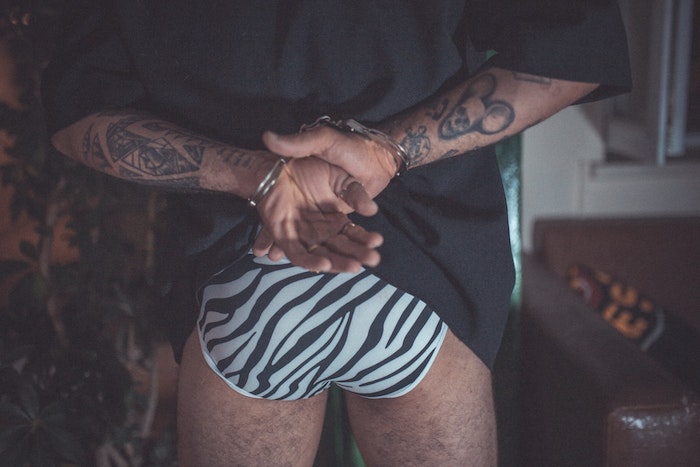Bottom. Top. Switch. What do these terms mean?
In the world of BDSM, there’s a wide variety of roles that people can take on. Some people identify as tops, bottoms, or switches, depending on their preferred dynamic. For queer people, there’s an additional layer of complexity to these roles.
In this article, we will explore the different ways queer tops, bottoms, and switches can express their sexuality in BDSM relationships.
What is a Top?

The dominant top is the archetype from which all other roles are derived. They take the dominant role in a BDSM relationship or activity. They’re typically the ones in control. They set the rules and limits for the bottom. The dominant top may also be the one who decides what activities will take place, and who initiates and controls the sexual activity.
They may also be the dominant partner in a non-sexual relationship, such as a 24⁄7 Master/slave relationship. A male dominant top may also be referred to as a Dom, Master, Daddy, or Sir. A female dominant top, on the other hand, is called Domme, Mistress, Madam, or Mommy.
From this basic role, there are many different variants. Here are some of the most notable ones.
The abusive top
An abusive top uses their position of power to control, demean, and hurt their submissive partner. They may use physical or emotional abuse, or a combination of the two, to maintain control over their victim. Abusive tops may also threaten or use force to get their way or to keep their partner from leaving the relationship.
The stone top

A stone top is a dominant partner in a BDSM relationship who is typically unemotional and uninvolved in the submissive partner’s emotional life. The stone top may use physical and/or psychological techniques to maintain control over the submissive partner.
Stone tops are often seen as a “rock” that their submissive partners can lean on for support and comfort because of their strong and unyielding persona. They may enjoy inflicting pain or humiliation on their submissive partners, but they do not derive any emotional satisfaction from it.
The aggressive top
An aggressive top is a dominant partner who takes a more active and sometimes more forceful role during BDSM play. They enjoy dominating and controlling their partners. They’re more likely to initiate activities and be more vocal in their commands. An aggressive top may also be more likely to engage in activities their partner may not be comfortable with, such as trying new things or pushing boundaries.
The service top

A service top, just like any regular top, takes an active role in the power exchange. But, at the same time, they’re told what to do by their bottom partner. For example, they administer the punishment, but they do so under the instruction of the bottom.
So instead of dominating their partners, a service top acts according to what their bottom wants and what pleases them. For example, the bottom either chooses the punishment or tells the top how many strokes to implement when being spanked. Given their nature, they may also be considered a soft dom, a new breed of dominant.
Most professional doms may be considered as service tops. But there are also those who simply don’t want to be too domineering. You won’t see them every day, but they do exist. They’re often discriminated against within the BDSM community for deviating too much from the traditional BDSM power dynamic.
What is a Bottom?

A bottom, sometimes known as a submissive, is someone who enjoys submitting to the will of another person, usually in a sexual or BDSM context. It’s not always the case that they are submissive, though. They enjoy being controlled, humiliated, or even tortured, but only depending on their specific desires.
They’re often seen as the “receiver” in BDSM play, as they’re usually the ones who are being acted upon by the top. A good bottom will communicate their limits and desires to their partner, and trust them to push their boundaries in a safe and consensual way.
Not all bottoms are the same. After all, everyone is unique in their own ways. Here are some of the different types of bottoms.
The pillow princess

A pillow princess or a stone bottom is a woman who loves to be pampered and lavished with attention. They love to be cuddled and have their every need met. They also love to receive pleasure but make no effort to reciprocate. They’re often happy to just lie back and be pleasured, hence the name.
Pillow princesses are usually submissive women, but men can be pillow princes too. Simply put, a pillow princess only wants to be the receiving partner in any sexual activity.
There’s a huge stigma that stone bottoms are lazy and selfish. In fact, they’re often criticized for their specific sexual preferences within and outside the queer community. Sleeping with a sexually passive woman may sound like a bummer.
But the whole sexual experience doesn’t have to suck. There are some upsides to it. For example, you get full control over the whole encounter while she chills and lies flat on her back. That means you get to do what feels good for you.
The bratty bottom
A bratty bottom is someone who likes to push their dominant’s buttons by being disobedient or naughty. They may do this by testing limits, refusing to cooperate, engaging in verbal or physical resistance, or trying to top from the bottom. While this behavior can be frustrating for the top, there are many different ways to handle a bratty bottom when they’re being, well, bratty.
The resistant bottom

While bratty bottoms resist in terms of attitude, resistant bottoms physically fight back. They may even want to top from bottom. They do so until they’re overcome or there’s no more fight left in them. Being with a resistant bottom can be very physical, often resulting in heavy action while the top tries to master the bottom. But the rough tumble gets the endorphins and adrenaline flowing.
The bossy bottom
Bossy bottoms like taking a dominant or controlling role in a BDSM scene or relationship, even though they’re technically the submissive or bottom partner. They’re usually the ones who decide what is going to happen and when it’s going to happen. For example, they decide how many strokes to receive when they get punished.
They know exactly what they want and aren’t afraid to ask for it. They just need someone to fulfill their fantasies for them. They may be pushed to their limits, but only if they want to. This very nature makes them the perfect partner of service tops. That said, not all tops enjoy being with a bossy bottom. So if this is you, you should make it clear from the get-go to avoid real conflict or disappointments.
The humiliation bottom

A humiliation bottom is a submissive who enjoys being humiliated by their dominant partner. This can involve anything from being called names and made to feel inferior, to being physically humiliated and degraded. Some would even go so far as to explore taboos, such as scat and blood play.
For some people, being humiliated is a way of increasing their feelings of submission and subservience, and it can be a highly erotic and satisfying experience. Of course, before you engage in humiliation play, make sure you understand all the risks and dangers involved, especially when sharing blood.
The responsive bottom
As the name implies, responsive bottoms are responsive to their partner’s cues and signals during BDSM play. They easily pick up what their partner is trying to communicate, whether it’s through body language, verbal cues, or both. This is an important aspect of BDSM play, as it helps ensure both partners get the most sexual pleasure out of the scene.
Responsive bottoms actively participate in play and enjoy receiving pain. They may moan, scream, or cry during scenes, making it more satisfying to be a top. They have no wish to fight for dominance and are more than happy taking directions, so they’re generally seen as a “good” submissive.
What is a Switch?

A switch is someone who enjoys both top and bottom roles. Some people switch roles within the same scene, while others only do so between scenes. They can be in a relationship with bottoms, tops, or other switches depending on their preferences.
Some switches enjoy playing both roles equally, while others may have a preference for one or the other. Switching can add an extra layer of excitement to BDSM play as it allows for more variety and can keep things fresh.
BDSM in the LGBTQ Community
There’s a widespread notion that BDSM is only for heterosexual couples. This can’t be farther from the truth. Yes, there are a lot of dominant-submissive straight couples. But that’s just one variant of BDSM.
Gay men, lesbians, queers, and non-binary people can also be kinky. In fact, the BDSM community is more accepting of people who are attracted to the same sex.
There’s something about BDSM that just seems to fit perfectly with the LGBTQ community. Maybe it’s because both groups are often misunderstood and marginalized by society. Or maybe it’s because both groups are often incredibly creative and open-minded. Whatever the reason, BDSM has become a popular activity among LGBTQ people.
There are now entire clubs and events devoted to LGBTQ BDSM, and it’s not uncommon to see rainbow flags hanging alongside the BDSM equipment. For many queer people, BDSM is a way to explore their sexuality in a safe and accepting environment. It’s a chance to let go of all restrictions and expectations society places on them, and to just be themselves.
Plus, BDSM helps build trust, communication, and intimacy with a partner. It can also be a lot of fun. Whether you’re into spanking, bondage, or role-playing, there’s a place for you in the BDSM community.
If you’re interested in exploring BDSM, there are many resources available to help you get started. There are also numerous events and clubs that you can attend to meet other queer people who share your interests. With a little exploration, you’re sure to find the perfect BDSM experience for you.
Navigating Sexual Pleasure as a Queer

Queer people don’t experience sexual pleasure any differently from heterosexual people. So whatever your sexual identity is, the same “rules” apply. Just like in any relationship, it’s important to communicate with your partner about your desires, boundaries, and limits. It’s also important to be aware of your own body and what feels good for you.
There are a variety of sex toys and BDSM equipment that can be used to enhance sexual pleasure. For example, blindfolds can increase the sense of anticipation and suspense, while restraints can create a sense of vulnerability and surrender.
It’s also important to be aware of your own body and what feels good for you. What turns you on? What makes you feel good? Experiment with different kinds of touch, pressure, and stimulation to find out what gets you going.
Don’t be afraid to ask for what you want. If you’re not sure what you want, that’s OK, too. Communication is key in any sexual relationship, but it’s especially important in BDSM. By communicating openly and honestly with your partner, you can create a sexual experience that is pleasurable, safe, and satisfying for both of you.
Ultimately, it’s up to each individual to explore what pleases them within the BDSM dynamic. After all, every queer couple is unique and will have their own preferences when practicing BDSM.
How to Give and Receive Sexual Pleasure as a Queer
Society taught us that the only way to give and receive pleasure is through penis-in-vagina sex. But there are many ways to achieve sexual pleasure without penetration.
One way is to stimulate the clitoris with the fingers, using a circular or side-to-side motion. Another way is to use sex toys specifically designed for clitoral stimulation, such as vibrators or dildos.
Additionally, many people find that they can reach orgasm through anal stimulation, either with a finger or with a sex toy. There are also many different ways to stimulate the penis without penetration, such as through the use of the hands, mouth, or sex toys. Experiment and explore to find out what feels best for you and your partner.
Queer Sex: How Do Queers Lose Their Virginity

They say everyone remembers their first time. But for queer people, that adage doesn’t always ring true. While some do have their first sexual experiences with penetration, many don’t. And that’s perfectly okay!
For queer people, virginity loss can look like a lot of things. Maybe it’s finally mustering up the courage to make out with someone you’ve been crushing on for months. Maybe it’s exploring your own body for the first time. Maybe it’s experimenting with different kinds of stimulation, such as oral sex or masturbation, and finding out what gets you off.
There’s no one right way to lose your virginity, and that’s especially true for queer people. So however you do it, just know that there’s no wrong way to do it. As long as you’re enjoying yourself and exploring your sexuality in a safe and consensual way, you’re doing it right.
Does Oral Sex Count as Real Sex?
Many people think oral sex isn’t real sex because there’s no penetration in a traditional sense. Well, newsflash! Oral sex is definitely real sex!
There’s no denying that when you’re getting or giving oral sex, you’re definitely engaging in sexual activity. For some people, oral sex is even more intimate than traditional penetrative sex, as it requires a higher level of trust and communication. Not to mention, it feels pretty darn good!
While it’s not as “traditional” as other sexual activities, that doesn’t make it any less real or valid. Oral sex is just another way to enjoy and express your sexuality—and there’s nothing wrong with that.
Final Thoughts
There’s no right or wrong way to be in BDSM. People of all orientations can find a place within the world of kink. Whether you’re straight or queer, BDSM can be a way to reclaim your body and sexuality.
If you’re a top, you can explore the dominant side of your sexuality. If you’re a bottom, you can let go of control and surrender to your desires. And if you’re a switch, you can play both roles. No matter what your sexual preferences or orientation, BDSM can be a fun, sexy, and liberating experience. So go out there and explore your kinky side!





